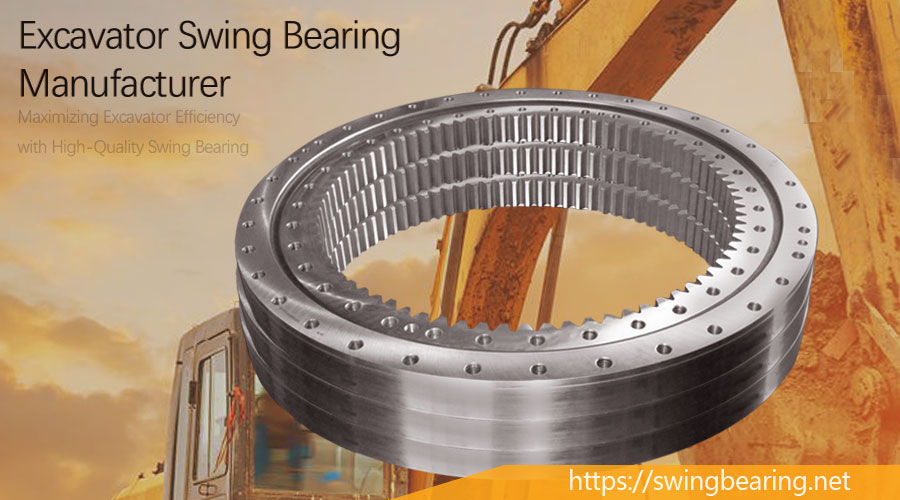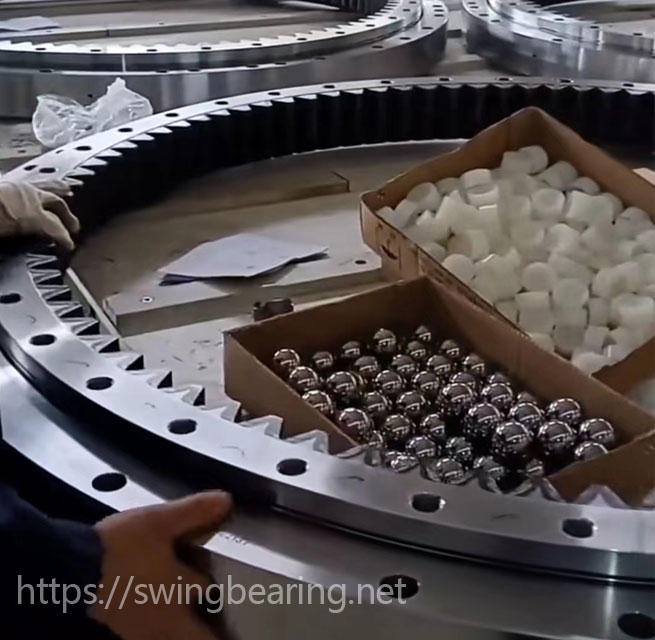
The excavator swing bearing is an essential component that plays a pivotal role in the rotational movement of heavy machinery. It not only supports the weight of the upper structure but also handles the working loads during operation. Given the high demands placed on these bearings, they are often subjected to heavy loads and harsh conditions, making them prone to tooth breakage. This article explores the primary reasons for tooth failure in excavator swing bearings and provides practical solutions for addressing these issues.
Kääntyvät laakerit are integral to the smooth and efficient operation of excavators, enabling the machine to rotate left and right. The gear teeth of these bearings mesh with the pinion to transmit motion. However, due to factors like high operational loads, misalignment, and inadequate maintenance, the teeth of swing bearings are susceptible to damage. Tooth breakage can occur early in the lifecycle of the bearing, often within the first year of use, if not properly addressed.
Key Causes of Swing Bearing Tooth Breakage
The reasons for tooth breakage in excavator swing bearings are varied but often stem from internal meshing issues, improper clearance, and the effects of radial forces. Let’s examine these causes in detail.
The majority of tooth breakages in swing bearings involve internally meshing gears with hard tooth surfaces. Bearings with external meshing and soft tooth surfaces are less prone to this issue. In most cases, tooth failure results from the radial oblique extrusion that occurs during operation. The pinion, driven by a floating shaft, tends to shift slightly due to the high overturning moments exerted during heavy-duty tasks. This shift creates an inclination and radial displacement, altering the center distance of the gear transmission and increasing the stress on the gear teeth.
Over time, the factory-set clearance in swing bearings (typically less than 0.2 mm) may increase, leading to deformation in the raceway and greater tooth wear. If these changes are not accounted for during maintenance, the risk of tooth breakage escalates.
Several strategies can be employed to mitigate the risk of tooth breakage in excavator swing bearings. Below are practical solutions based on industry best practices.

One of the most critical aspects of preventing tooth breakage is ensuring the correct clearance between the meshing gears. For a standard 20-ton excavator, the recommended module for the swing bearing gear is 10 mm, with the backlash (gap between the large gear and the pinion) set at 0.6 mm or greater. In many cases, customers may overlook the importance of this clearance, leading to increased wear and a higher likelihood of tooth breakage.
Action Plan:
Switching to a helical gear swing bearing can significantly reduce the risk of tooth breakage. Modifying the swing ring gear by chamfering the teeth at a 37-degree angle helps distribute the load more evenly. This adjustment reduces the stress concentration on the upper half of the tooth width, which is the area most susceptible to damage.
Benefits of Using Helical Gear Swing Bearings:
Drum gear swing bearings offer several advantages in mitigating the effects of radial extrusion. The drum tooth design allows for greater angular displacement compensation when meshing with the pinion gear. This feature changes the contact conditions between the gears, reducing the impact forces that typically lead to tooth breakage.
Advantages of Drum Gear Swing Bearings:
| Gear Type | Ominaisuudet | Edut | Sovellukset |
|---|---|---|---|
| Standard Straight Gear | Simple design, easy to manufacture | Low cost, easy replacement | Light to medium-duty excavators |
| Helical Gear | Angled teeth, chamfered design | Better load distribution, reduced stress | Heavy-duty excavators |
| Drum Gear | Curved tooth profile, large compensation | Reduced extrusion, longer service life | High-impact and heavy-duty environments |
What are the common causes of tooth breakage in swing bearings?
Tooth breakage is usually caused by improper meshing, excessive radial forces, inadequate lubrication, and insufficient gear clearance.
How can I prevent tooth breakage in my excavator swing bearing?
Maintain proper gear tooth clearance, use high-quality lubricants, and select the appropriate gear design (e.g., helical or drum gear) to match the operating conditions.
How often should I inspect the swing bearing for potential tooth damage?
Regular inspections should be conducted every 250 to 500 hours of operation, depending on the machine’s workload and the environmental conditions.
What are the benefits of using a helical gear swing bearing?
Helical gears offer better load distribution, reduced stress on individual teeth, and an extended service life due to their angled tooth design.
Is it possible to repair a swing bearing with broken teeth?
In most cases, it is more cost-effective to replace the bearing rather than attempt repairs, especially if the damage is extensive. However, minor tooth damage may be addressed through regrinding or reshaping, depending on the extent of wear.
Understanding the causes of tooth breakage in excavator swing bearings and implementing preventive measures can significantly enhance the durability and performance of your machinery. By maintaining correct gear tooth clearance, choosing suitable gear designs, and conducting regular inspections, you can minimize the risk of failures and extend the lifespan of these critical components. Proper maintenance not only reduces downtime but also contributes to the overall efficiency and productivity of your excavator.